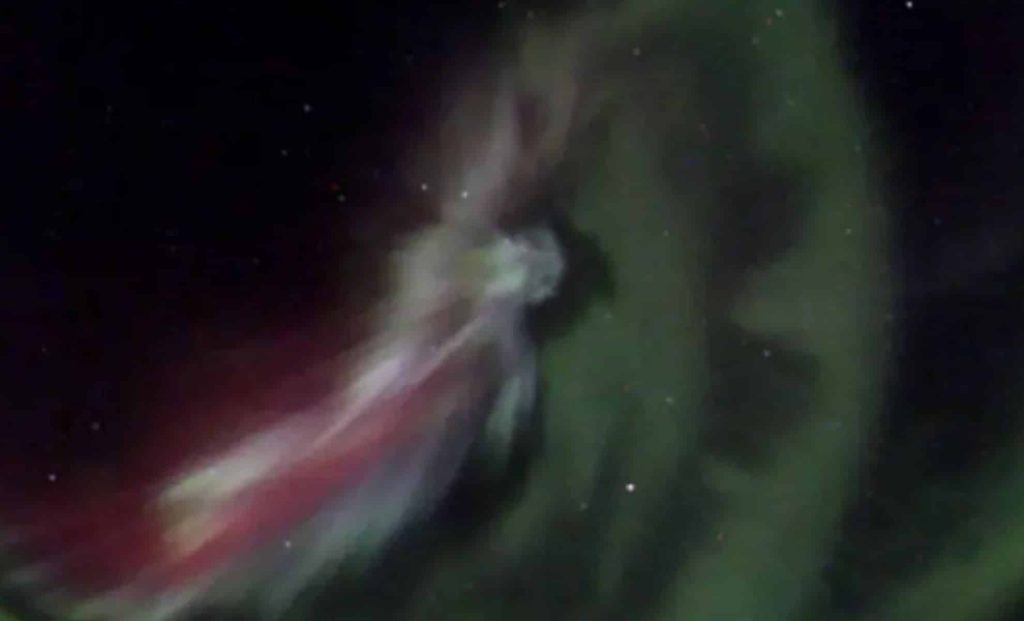Scientists Discover Mysterious Pale Glow Embedded in Northern Lights – The Daily Galaxy –Great Discoveries Channel

A strange pale grey glow has been spotted amidst the vibrant greens and reds of the aurora borealis, leaving scientists puzzled. Could this be a previously unknown atmospheric phenomenon? Advanced imaging tools are now helping researchers unlock the secrets of this mysterious light.Scientists have made a fascinating discovery in the skies above the northern latitudes, capturing images of a mysterious pale grey glow nestled within the vibrant greens and reds of the northern lights. This enigmatic light, observed by researchers at the University of Calgary, stands out as structured patches embedded in active auroras, defying conventional explanations of atmospheric phenomena. Unlike the typical hues produced by oxygen and nitrogen in the atmosphere, this grey-toned glow seems tied to complex and previously undocumented chemical reactions.The discovery adds an intriguing layer to our understanding of the aurora borealis, a natural wonder that has captivated sky watchers for generations. These structured patches may represent a novel atmospheric process, one that scientists are only beginning to unravel. For researchers, the presence of this glow presents a compelling puzzle, offering new opportunities to explore the dynamic interactions between solar particles and Earth’s upper atmosphere. This newfound phenomenon not only deepens our appreciation of auroral displays but also opens a window into the complex chemistry and physics shaping our planet’s skies.While the northern lights are known for their dynamic greens and reds, this new pale grey glow stands apart, leaving scientists intrigued. “You’d see this dynamic green aurora, you’d see some of the red aurora in the background and, all of a sudden, you’d see this structured – almost like a patch – grey-toned or white-toned emission connected to the aurora,” explained Emma Spanswick, a physicist at the University of Calgary. The unusual emission appears embedded within the auroras, making it distinct from previously known phenomena like STEVE (Strong Thermal Emission Velocity Enhancement), a mauve-colored band often seen in subauroral regions.The glow ranges in size from tens to hundreds of kilometers and is associated with active auroral regions. Initial findings suggest the patches may result from heat released during auroral activity, which triggers chemical reactions emitting a continuum of electromagnetic wavelengths. Despite its striking appearance, the exact mechanisms behind this phenomenon remain hypothetical.Auroras occur when solar particles collide with Earth’s atmosphere, causing oxygen and nitrogen molecules to emit light. While green and pink hues are well-understood as results of these interactions, the pale grey and white tones have no straightforward explanation. Scientists speculate that the glow may stem from unique chemical rearrangements triggered by auroral energy.“There are similarities between what we’re seeing now and STEVE,” Spanswick noted. Unlike STEVE, which is a clearly defined band separate from auroras, this new phenomenon is embedded within the aurora itself, making it more challenging to study. The grey patches may represent a novel chain of events involving atmospheric heating and complex molecular reactions.Unraveling the mystery of this pale grey glow would not have been possible without the aid of cutting-edge technology. The Transition Region Explorer, a high-resolution sky-imaging observatory, has proven invaluable in studying the auroras in unprecedented detail. Unlike traditional observational methods that rely on human interpretation, this observatory captures precise color-calibrated spectral data, enabling scientists to analyze the intricate blend of wavelengths within the auroras. This tool provides researchers with the ability to isolate and study the faint grey patches, offering clues about the processes producing this enigmatic light.The spectral data revealed that these patches, spanning sizes from tens to hundreds of kilometers, appear in conjunction with active auroras. They are believed to be caused by energy released during auroral activity, which then triggers chemical reactions capable of emitting a continuum of wavelengths. By combining spectral data with laboratory modeling, researchers aim to uncover the exact chemical and physical processes driving the phenomenon. This multi-faceted approach is expected to yield deeper insights into the workings of Earth’s atmosphere and its interaction with solar activity.Key features of the grey glow observed include:The Transition Region Explorer’s capabilities have paved the way for ongoing research, allowing scientists to collect more examples of this glow, refine their models, and uncover new complexities in atmospheric chemistry.The discovery of this eerie glow signals an exciting new frontier in the study of Earth’s atmosphere. While the northern lights have been studied for centuries, this phenomenon shows there is still much to learn about the intricate processes taking place high above our planet. The patches of pale grey light could represent a previously unknown interaction between auroral energy and atmospheric molecules, offering a glimpse into how subtle chemical and physical changes produce visible effects.Researchers are now turning their attention to replicating these processes in laboratory settings, aiming to confirm their hypotheses about the glow’s origins. By modeling the layers of the atmosphere and testing the effects of different energy inputs, they hope to reconstruct the sequence of events that leads to the formation of these grey patches. This approach will not only help explain this specific phenomenon but could also reveal broader insights into the behavior of Earth’s upper atmosphere.Beyond its scientific significance, the discovery has cultural and aesthetic implications, adding a new dimension to the already awe-inspiring northern lights. For sky watchers and aurora enthusiasts, the knowledge that these grey patches may hold untold secrets further enhances the wonder of these celestial displays. As scientists continue to gather data and refine their understanding, the discovery serves as a reminder that even well-studied natural wonders can still surprise us.Moving forward, researchers plan to:This discovery highlights the dynamic and ever-changing nature of Earth’s atmosphere, encouraging further exploration and innovation in the field of atmospheric science. With each step, scientists uncover more about the unseen forces that shape the spectacular displays above, reminding us of the profound mysteries still waiting to be solved.Got a reaction? Share your thoughts in the commentsEnjoyed this article? Subscribe to our free newsletter for engaging stories, exclusive content, and the latest news.Comment Save my name, email, and website in this browser for the next time I comment.
© 2024 | Daily Galaxy | All rights reserved
Source: https://dailygalaxy.com/2025/01/scientists-pale-glow-northern-lights/






